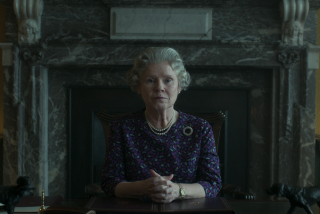Hillary’s Role as Consort--Think Marie de Medici : Power: This Administration, with its strong First Lady, has two lines of authority, similar to those that used to develop in the royal courts of Europe.
- Share via
WASHINGTON — Until Hillary Rodham Clinton entered the White House, monarchies had been the only equal-opportunity employer for head-of-state wannabes.
But suddenly, all of us Europeans are back on familiar ground because it’s consort time again. Just as it was when Prince Albert of Saxe-Cobert married Queen Victoria in 1840, to bring us suspicious Brits the Christmas tree, state-sponsored museums and the first world’s fair, the Great Exhibition of 1851.
That sounds a suspiciously modest agenda for Hillary Clinton. She seems to take more after Eleanor of Aquitaine, the fighting queen who led her troops on the Second Crusade dressed as an Amazon, and inspired the troubadour poets.
It was Eleanor who really founded the modern consort profession--where there were two distinct lines of power, one extending from the king and one extending from the queen. In 1137, she became Queen of France by marrying Louis VII. After 15 years, she ditched him and quickly snatched back the royal title by marrying Henry Plantagenet, count of Anjou. Strengthened by her dowry of Aquitaine--the fertile southwest of France that then, as now, did well from Bordeaux wines--Henry became king of England two years later. And Eleanor had her crown again.
History suggests a parallel here, and a warning. Consorts bring useful assets like a province, a dynastic alliance or, in modern days, a liberal and feminist constituency. But they can also bring trouble. After Eleanor joined her sons Richard the Lionheart and Prince John in rebellion against King Henry, she was imprisoned for 15 years.
We can take some comfort from that embarrassing incident when the White House steward walked into the presidential bedroom unannounced. At least he found the First Couple sleeping in the same bed.
As with Britain’s Prince Charles and Princess Di, the trouble seems to start when they take separate suites. On the first royal visit to newly free Czechoslovakia three years ago, Charles and Diana were given not just different suites but different floors. The rest is history.
Different domestic establishments means different courts--which mean different courtiers, with their own agendas to promote. This is not the place to explore the liberal ideals of the saintly Marion Wright Edelman, Hillary’s college inspiration and first employer. But it might be useful to recall the instructive tale of Marie de Medici and Cardinal Richelieu.
Marie was well up to the consort ambitions of Eleanor of Aquitaine. The daughter of King Francis I, wife of King Henry IV and mother of Louis XIII, she ruled as regent after the assassination of her husband. Marie’s skill was to keep two different kinds of courtier.
The first were the Italian boytoys, like Marie’s young lover Concino Concini, who were kept firmly in their place. (When Concino got ambitious, the future King Louis discreetly arranged for his assassination.) Marie’s second form of courtier was the modern equivalent of the national-security adviser.
This is not to say that Richelieu has anything in common with Anthony Lake or even Brent Scowcroft, both men of blameless personal habits. But Richelieu had an agenda of his own to promote, and such courtiers can be dangerous.
He became indispensable by saving Marie’s throne from popular unrest in 1616, and embarked on the great expansion of French power through the wars against Austria and Spain. By the time the young King Louis XIII came of age, Richelieu had switched allegiance, and Marie spent the closing years of her power intriguing against him. She lost, and was sent off to exile in Brussels.
But there was no end to the damage done by Marie de Medici’s consort ambitions. Her entire foreign policy was based on the consort principle, arranging for the marriage of her son to Anne of Austria, the daughter of King Philip of Spain. As double insurance, she also married her eldest daughter, Elizabeth, to the king of Spain’s heir, the future Philip IV.
The marriage of Anne of Austria and Louis XIII has been immortalized by Alexandre Dumas’ tale of “The Three Musketeers,” who were members of the regiment loyal to the king, and thus foes of Richelieu. Romantic historical fiction being what it so gloriously is, the legend has it that d’Artagnan and his Musketeer chums were even more loyal to the queen, Anne of Austria, who had developed a tendresse for the English ambassador, the duke of Buckingham.
She gave Buckingham some diamond studs that had been given her by her husband, the king. Inspired by the wily Richelieu, Louis said how much he looked forward to seeing her wear them at the next ball. To save her conjugal honor, d’Artagnan and his chums rode and fought their way past the cardinal’s men to England, to get the jewels back.
Soap operas pale beside history. Hollywood would never dare invent this consort stuff. The plot thickens, because the duke of Buckingham had come to France to arrange the marriage of England’s King Charles I to the intensely Catholic sister of the king of France, Henrietta Maria, the event that helped plunge England into the Civil War between Charles and Parliament.
Nothing to do with us American Republicans, you might say. Fiddlesticks. Who was the hapless fellow who was inspired to assassinate the duke of Buckingham? A Puritan. Who brought their Christian fundamentalism to the new land across the seas and establish the white man’s America? Puritans. I rest my case.
And do not make the error of assuming these dynastic alliances are nothing to do with Gods’s own country. Who carefully arranged the meeting between Britain’s Prince Charles and his daughter Patricia, with regal wedding bells ringing distantly in his ears? None other than California’s own Richard Nixon. Come to think of it, pre-empting Princess Di with Princess Trish might have saved us all trouble.
The historical moral here might seem to be: keep the consort out of foreign policy. And with Queen Hillary concentrating on health reform, and keeping a sisterly eye on Janet Reno at the Justice Department and Donna Shalala at Health and Human Services, it looks as if America’s new reigning consort might be content with the home front.
But bear in mind what happened to Peter the Great’s grandson, Czar Peter III, when he dabbled in foreign policy while his wife was presumably busy with her domestic affairs--Gregory Orlov and Count Poniatowski, to name but two. Poor Peter inherited the throne in January, 1762, and was ousted by his wife, her lovers and the nobles within six months, and later strangled. And that lady of ferocious intelligence and inexhaustible appetites, known to history as Catherine the Great, then used her domestic power base to assume full powers.
Those pesky courtiers again. But consider Catherine’s domestic reforms. She overhauled the Russian health system, building hospitals and encouraging smallpox vaccinations. She promoted the education of women and pursued liberal ideals--without ever putting them into practice.
This has an uncannily familiar ring. But history has happier examples. Take the useful, if childless marriage of William and Mary, joint King and Queen of England after the Glorious Revolution of 1688. They won wars, and founded the Bank of England. The trouble was, that by creating the great institution called the national debt, they also established the practice of budget deficits.
But there was one great merit to these monarchs and their consorts. They never made much fuss about women at the top--and left it to the American Founding Fathers to institutionalize sexism at the very top of politics.
More to Read
Sign up for Essential California
The most important California stories and recommendations in your inbox every morning.
You may occasionally receive promotional content from the Los Angeles Times.













